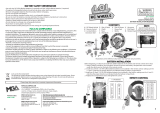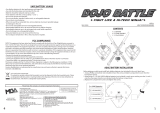Page is loading ...

2
1
INTRODUCTION
BATTERY INSTALLATION
Ask an adult to help you install batteries by doing the following:
1. Leaving the neck portion of the swimsuit top tied, undo the outer Velcro™
fastener on the lower portion of the swimsuit and unwrap the ties. (See Fig. 1)
2. Undo the inner Velcro™ fastener. (See Fig. 1)
3. Using a Phillips screwdriver (not included), remove the two screws and the
battery compartment cover. (See Fig. 2)
4. Install two (2) AAA alkaline batteries making sure the (+) and (-) ends face the
proper direction as indicated inside the battery compartment. (See Fig. 3)
5. Replace the battery compartment cover and tighten the screws firmly to ensure
the compartment seal will be watertight.
6. Secure the inner Velcro™ fastener, rewrap the ties, and secure the outer
Velcro™ fastener. (See Fig. 4)
REPLACING BATTERIES:
• Dry the Little Mermaid thoroughly before the opening battery compartment.
• If moisture is present in the battery compartment, dry it with a towel.
• Install the new batteries as instructed above.
CONTENTS
a. 1 Swimming Little Mermaid Doll with Body Art
b. 1 Floating Seahorse Friend
c. 1 Waterproof Illustrated Storybook
Ages 3+
Item no.: 334965
a.
b. c.
This beautiful princess was always one of the fairest in the land! However, well
before she set foot on the shore, she was a Princess under the sea. Now you can
take the Little Mermaid back to the water with the Storytime Collection™ Special
Edition Mermaid!
Adult Battery Installation Required
Illustrations may vary from actual contents.
Fig. 1
Fig. 2
Fig. 3
Fig. 4
2 x AAA Batteries
1.5V AAA/LR03
1.5V AAA/LR03

Going for a swim:
IMPORTANT: This toy is to be operated in water only when it is fully assembled in
accordance with the instructions.
• Totally submerge the Little Mermaid (and Seahorse) in water until no air bubbles
appear on the water surface to assure they both will swim evenly balanced.
• When the water touches both of the sensors (just under the top edge of her tail
on her backside), the Little Mermaid will immediately begin to swim.
• When lifted up and her sensors no longer touch the water, she will stop swimming.
• Add her floating Seahorse Friend for even more water fun!
CAUTION: Do Not allow children to play with this toy in water without ADULT
SUPERVISION.
NOTE: When removing the Little Mermaid from the water, lift her up and allow all
excess water to drain, then place her on a towel. (NOTE: Water will drain from the
small holes in her tail. They are created just for that purpose.)
IMPORTANT: After play, drain excess water from the holes in the tail, dry the doll
thoroughly and bring indoors. Prolonged exposure to sunlight will cause irreparable
damage to the soft tail material.
NOTE: A slight clicking sound may be heard when bending the mermaid at the waist
or when she swims. This is normal.
On dry land:
• With the Little Mermaid on dry land, have fun brushing her hair (brush not
included), reading her storybook and presenting her with her princess tiara.
Storing your Little Mermaid:
• Allow the Little Mermaid, her clothing, and her Seahorse Friend to dry thoroughly
in a well-ventilated area before storing.
• If she will not be played with for an extended period of time, remove the
batteries to prevent possible corrosion and damage to the toy.
4
3
QUICK START
SAFE BATTERY USAGE (con‛t)
SAFE BATTERY USAGE
FCC STATEMENT
WARNINGS CAUTIONS AND NOTES
Please keep this manual as it contains important information.
0207-3
The preferred method of contact for
Customer Service is through our e-mail
contact form at www.mgae.com
NOTE: This equipment has been tested and found to comply with the limits for Class
B digital device, pursuant to Part 15 of FCC Rules. These limits are designed to provide
reasonable protection against harmful interference in a residential installation. This
equipment generates, uses and can radiate radio frequency energy and, if not installed
and used in accordance with the instructions, may cause harmful interference to radio
communications. However, there is no guarantee that interference will not occur in a
particular installation. If this equipment does cause harmful interference to radio or
television reception, which can be determined by turning the equipment off and on,
the user is encouraged to try to correct the interference by one or more of the
following measures:
• Reorient or relocate the receiving antenna.
• Increase the separation between the equipment and receiver.
• Connect the equipment into an outlet on a circuit different from that to which the
receiver is connected.
• Consult the dealer or an experienced radio/TV technician for help.
This device complies with Part 15 of the FCC Rules. Operation is subject to the
following two conditions: (1) This device may not cause harmful interference, and (2)
this device must accept any interference received, including interference that may
cause undesired operation.
Warning: Changes or modifications to this unit not expressly approved by the party
responsible for compliance could void the user‛s authority to operate this equipment.
MGA Entertainment Storytime Collection™ and
all related logos, names, characters, distinctive
likenesses and slogans, as well as the packaging
and images appearing thereon, are the exclusive
property of MGA.
16300 Roscoe Blvd.
Van Nuys, CA 91406 USA
(800) 222-4685
Patent Pending
Printed in China
Before placing the Little Mermaid in water:
• Make sure the battery compartment is securely closed and sealed and the screws
are tightened firmly to assure the compartment is watertight.
• To swim well, the Little Mermaid‛s body must be straight (as if lying down.)
•The Little Mermaid will swim with her arms stretched out in front of her or with
her arms to her sides. Both arms must be positioned in the same direction or she
may not swim in a straight line. (See Fig. 5)
• Do not recharge non-rechargeable batteries.
• Exhausted batteries are to be removed from the toy.
• Do not dispose of batteries in fire as they may leak or explode.
• Use alkaline batteries for best performance and longer life.
• Use only the type battery recommended for the unit.
• Batteries should be replaced only by an adult.
• Insert batteries with the correct polarity ( + and – ).
• Do not mix different types of batteries or old and new batteries.
• Do not short-circuit batteries.
• When not used for an extended time, remove batteries to prevent possible leakage
and damage to the unit.
• Do not mix rechargeable and non-rechargeable batteries.
• Rechargeable batteries are to be removed from the toy before charging.
• Rechargeable batteries are to be recharged only under adult supervision.
3
WARNING:
• DO NOT allow children to play around water unsupervised.
• DO NOT allow children to play in water near any electrical source or apparatus in
order to avoid electrical shock and/or electrocution.
• DO NOT leave Mermaid or Seahorse near electrical source or apparatus when wet.
CAUTION: Some children and adults may experience an allergic reaction to glitter.
If this occurs, stop playing with the toy and seek medical attention.
NOTES:
• Handle the Mermaid‛s tail as little as possible to prevent glitter loss.
• If glitter remains on your hands, wash them thoroughly and DO NOT allow them
near your eyes or mouth.
• After removing Mermaid from water, dispose of water, do not reuse it for any
purpose.
• Play with your Mermaid in fresh, clean, clear water only.
• DO NOT bend the tail of the Mermaid as it may cause irreparable damage.
• DO NOT attempt to push the Mermaid‛s feet through the tiny water drainage
holes at the bottom of the tail as it will cause irreparable damage.
• DO NOT place mermaid in extremely hot or extremely cold water.
Fig. 5
sensors
/













